Recognition in the workplace is a vital contributor to employee engagement and happiness. Although traditional recognition practices seem simple, they become more complex as workplaces modernise. However, feeling appreciated is integral to the employee experience.
Salary is no longer the sole driver for employees in their roles and recognition is high on the agenda. Studies have shown that the intention to leave a role was twice as high amongst those who did not receive workplace recognition.
In this guide you will find out:
- What is Employee Recognition?
- Importance of Employee Recognition
- Employee Recognition Examples
- Employee Recognition Tools
- The Benefits of Employee Recognition to Your Employees
- How to Encourage Employee Recognition in the Workplace
What is Employee Recognition?
Employee recognition is the act of acknowledging or praising a worker publicly or in private. These acts are usually the open appreciation of employee behaviour, contributions or achievements. Employee recognition practices can motivate not only the recipient but also their colleagues.
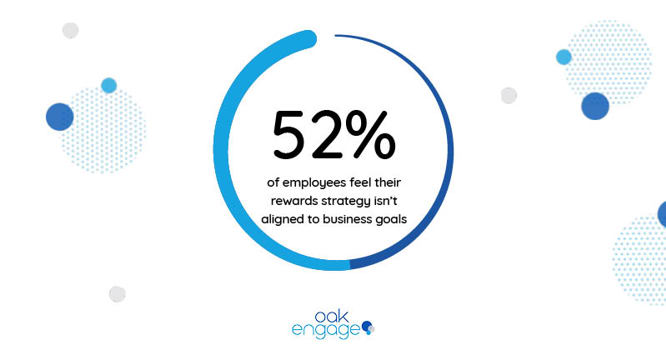
Despite the necessity of regular acknowledgement and reward, 52% of employees feel that their rewards strategy isn’t aligned with organisational goals.
Importance of Employee Recognition in The Workplace
The importance of employee recognition cannot be overstated. Recognising employees is pivotal to success. It is directly linked to engagement, retention, productivity and pretty much everything else.
A Workplace Trends report found that recognition programmes yield 27% higher profits on average. This shows that the bottom line is significantly impacted by consistent employee recognition strategies.
With all of this in mind, a business without effective recognition and reward programmes is missing out on many benefits.
Employee Recognition Examples
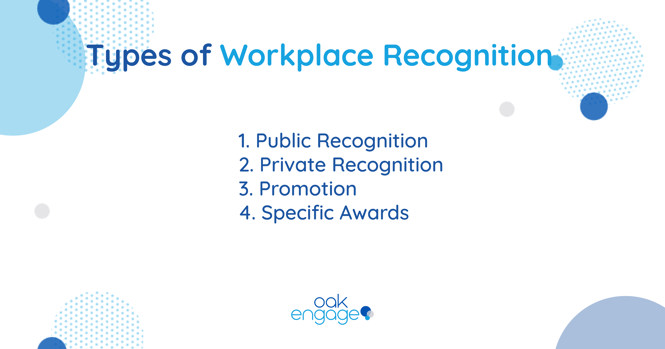
Public Recognition
Public recognition in the workplace makes appreciation towards employees a company-wide exercise. This can be an opportunity for participation from colleagues and the wider organisation. Not only does this mean colleagues are involved in the process but also provides motivation.
Examples of Public Recognition in the workplace:
- Post to intranet social feed
- Post to social media channels
- Congratulatory company-wide email
- Feature in the company newsletter
Private Recognition
Private recognition is in a one-on-one setting, usually carried out in a private meeting or chat. This method can mean that appreciation is more personalised and fitting to the individual.
However, there is also an argument that private recognition in the workplace can be more appropriate on some occasions. If an employee is receiving a bonus or reward for their work, it may be best served to keep private if it would cause issues among the wider group.
Examples of Private Recognition:
- 'Thank you' meeting - virtual or physical
- Congratulatory message over company intranet or text
- Send a video of an appreciation message
Promotion
A Linkedin study found that employees who get promoted within three years have a 70% chance of staying at their current company. Those who don’t progress only have a 45% chance of remaining for longer than three years.
Trusting your workers' talents in the form of added responsibility is key to retaining talent. It is generally perceived to be the most significant way to recognise employees. Of course, this needs to be used more sparingly than other methods.
Examples of promotion based rewards:
- New job title
- Inclusion in important business decisions
- Meeting to executive/leadership meeting
Awards
Awards can be crucial to your employee recognition system. They show the value you place in employees beyond just monetary compensation.
By having award schemes you can reward specific contributions, but it can also help to formalise the process. In turn, this will make it more regular and established. Awards can also help to connect employees with the organisation and work towards brand alignment.
Examples of awards:
- Bonuses
- Incentive trips
- Additional annual leave
- End of year company awards
Employee Recognition Tools
Having the intent to reward employees is all well and good but it can be difficult to implement an effective recognition process without the right tools. Without them, it can become an irregular and confusing process.
Not only this, but a lack of tools makes appreciation for remote and deskless teams difficult to conduct. These are some of the employee recognition tools your business can use:
- Instant messaging
- Social news feeds
- Staff directories
- Employee recognition applets
- Video chat- Teams, Zoom, etc
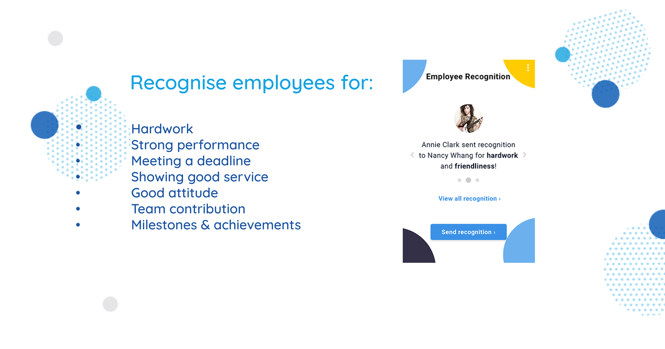
The Benefits of Employee Recognition to Your Employees
Employee Recognition and Better Culture
By adopting recognition in the workplace, you encourage employees to recognise each other's achievements. This can help to create positive relationships within the business and a generally more positive environment to work in.
What it can also achieve is developing healthy competition in teams with the added incentive. It can help cultivate hard work and motivation as part of the team’s fabric.
Employee Recognition and Less Stress
Positive reinforcement and recognising the hard work of your employees can help relieve stress. By reminding them that they’re on the right path and doing good work, you give them peace of mind.
A work environment where positivity is key will reduce stress. But where there is a lack of , there can be an increase in stress related illness.
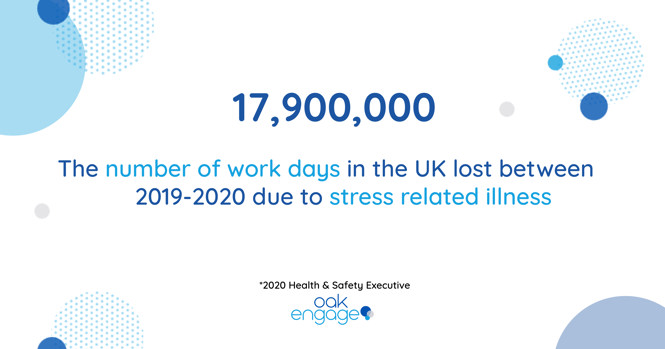
The 2020 Health & Safety Executive study reported that 17.9 million days were lost due to work related stress in the UK between 2019 and 2020. A little recognition can go a long way to improving the mental health of employees.
Employee Recognition and Job Satisfaction
Employee satisfaction is how happy they are in their jobs and in the work environment. Employee recognition is such an effective way of improving job satisfaction and is a main driver
An employee benefits survey found that 85% believe that workers should be rewarded for a job well done. This demonstrates the importance of it to employees. Furthermore, author Jacob Morgan stated that appreciation was the top cause of job satisfaction.
The Benefits of Employee Recognition to Your Organisation
Employee Recognition and Organisation Performance
Appreciating your employees is a simple, yet highly effective driver of productivity. 90% of workers said recognition makes them work harder.
This just shows how important appreciation is to the extent that it provides inspiration for higher output. When you can boost productivity in 9 out of 10 of your workforce, your revenue will react accordingly.
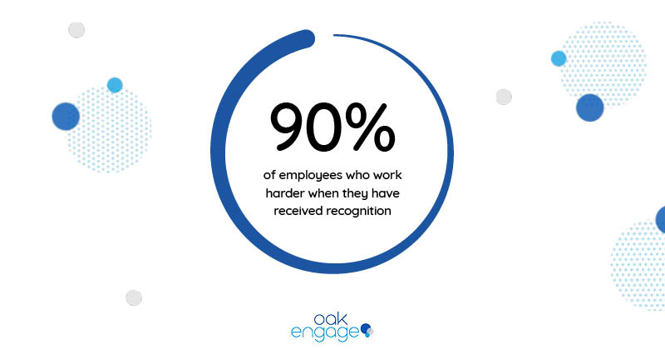
Employee Recognition and Employee Engagement
72% of business leaders say recognition has a significant impact on employee engagement. It is clear that leaders who have adopted a culture of appreciation, are seeing the knock-on effect.
If an employee’s hard work frequently goes unnoticed, they may feel disheartened and lose confidence. On the flip side, when employees feel valued they are likely to be assertive and motivated in their duties.
Employee Recognition and Employee Retention
Employee retention is a problem facing a lot of businesses. A Monster study showed that the turnover rate in the UK is at a 15% yearly average.
There is a remedy to this. The more your workforce feels appreciated, the higher your retention rate. 63% of employees who receive recognition are unlikely to leave their current role.
Given the cost of losing an employee is £11,000 recognition can demonstrate significant ROI. The links between retention and appreciation should be considered.
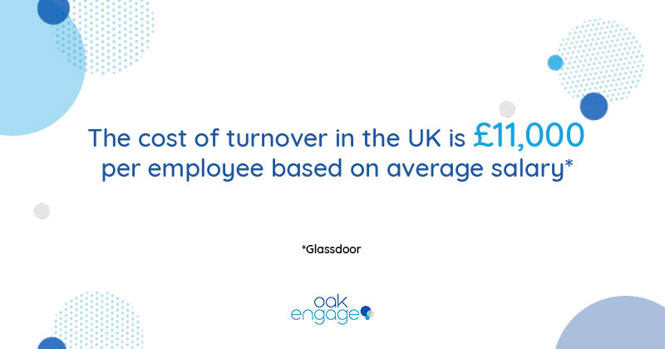
Recommended Reading 📖: What is Employee Engagement? The Ultimate Guide for 2021
How To Encourage Employee Recognition in the Workplace
Employee recognition is driven mainly by company culture and tools at the businesses disposal. This guide will have demonstrated the many benefits associated with recognition and reward. However, the question that remains is how do you make these a reality in your workplace?
Develop a strategy
No two workforces are exactly alike. You need to assess the appropriate tools to reach employees in all locations and time zones. Methods of reward to reach specific individuals will also need to be considered.
Achieve this by evaluating your current communication tools and receiving employee feedback. On the back of this research you can develop a recognition strategy and can map out processes.
Invest in employee recognition & rewards
An effective recognition and rewards programme may incur some cost, but the ROI is highly significant. As well as the savings of lower turnover, productivity will also increase as a result.
Investment may be needed in the form of technology and rewards themselves. An Oxford University study showed that happy workers are 13% more productive, so any money spent you will get back and then some by increased output.
Lead by example
Planning and investment are of course important, but your aims cannot be achieved if recognition is not embraced from the top. Your business needs to embody a culture of appreciation, starting with leadership.
In a Gallup workplace study, managerial recognition was the most memorable among employees. It impacts individuals through recognition, but also influences business culture. This makes it essential for leaders to be central to employee appreciation.
Want to learn more about how to engage your employees? Read our comprehensive list of ideas
Recommended Reading 📖: 21 Employee Engagement Ideas That Work


![Employee Recognition in The Workplace [Complete Guide]](/media/jjvctbal/employee-journey-mapping.jpg?width=50)

